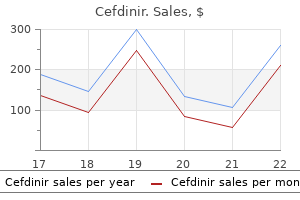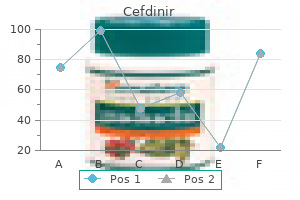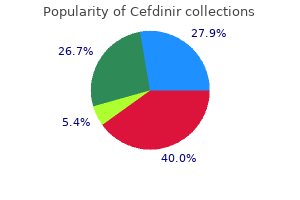





|
STUDENT DIGITAL NEWSLETTER ALAGAPPA INSTITUTIONS |

|
"Cheap 300mg cefdinir amex, bacteria model".
N. Leon, M.A., Ph.D.
Co-Director, University of South Alabama College of Medicine
In advanced cases of disorders characterized by increases in local or systemic venous pressure antibiotics c diff order cefdinir 300 mg on line, most notably in severe congestive heart failure and in cirrhosis virus killing robot cefdinir 300mg on-line, hyponatremia may occur; this finding represents an ominous prognostic sign antibiotics how do they work cefdinir 300mg visa. Finally infection games online cheap cefdinir 300 mg without prescription, edema formation due to such derangements of Starling forces may result in the "third space" phenomenon, namely, large volumes of interstitial fluid sequestered in regions such as the pleural or peritoneal cavities. For example, in acute glomerulonephritis, unidentified renal mechanisms are primarily responsible for edema. The recognition and management of volume-expanded states depend on proper identification and treatment of the underlying disorder. Clearly, the cornerstones of therapy in volume-expanded states characterized by sodium excess include salt restriction and diuretics. Table 102-5 provides a summary of some of the major diuretics used commonly and certain of their properties, whereas Figure 102-3 (Figure Not Available) summarizes the sites of action of the various families of diuretics. For convenience, these drugs have been classified according to their sites of action in the nephron. The cardinal example of a proximal tubule diuretic is acetazolamide, a carbonic anhydrase inhibitor that blocks proximal reabsorption of sodium bicarbonate. Consequently, prolonged use of acetazolamide may lead to hyperchloremic acidosis, in contrast to all other diuretics that act at loci prior to the late distal nephron. Late Distal Diuretics Aldosterone antagonists Spironolactone Non-aldosterone antagonists Triamterene Amiloride Na+:K+: 2Cl- absorption K+ loss, H+ secretion Hypokalemic alkalosis Hearing deficits, hypomagnesemia NaCl absorption K+ loss, H+ secretion K loss, H+ secretion + Hypokalemic alkalosis Hyperglycemia, hyperuricemia Hyperkalemic acidosis Na absorption + class of diuretics, blocks sodium chloride absorption in two nephron sites by unknown mechanisms. Specifically, in addition to an action on the early distal tubule, metolazone also inhibits proximal tubular sodium chloride absorption. Because the major locus for phosphate absorption is in the proximal nephron, the phosphaturia accompanying metolazone administration exceeds considerably that observed with other thiazide class diuretics. Proximal tubule diuretics are rarely used as primary diuretic therapy in modern practice. More commonly, these diuretics, particularly metolazone, are used as supplements to loop diuretics in instances in which loop diuretics alone are ineffective in producing diuresis. Loop diuretics, such as furosemide, bumetanide, and ethacrynic acid, produce diuresis by inhibiting the coupled entry on Na+, Cl-, and K+ across apical plasma membranes in the thick ascending limb of Henle. The latter is responsible for the reabsorption of approximately 25% of filtered sodium. The natriuretic dose-response characteristics of these diuretic agents are considerably more linear than those of all other currently used diuretics. Consequently, the loop diuretics are, for practical purposes, the most potent diuretics currently available; therefore, these drugs are commonly referred to as "high-ceiling" diuretics. Distal tubule diuretics, such as thiazide and metolazone, interfere primarily with sodium chloride absorption in the earliest segments of the distal convoluted tubule. The thiazide diuretics appear to exert their effect by blocking the NaCl co-transport mechanism across apical plasma membranes. With the exception of acetazolamide (which impairs bicarbonate absorption), hypokalemia and metabolic alkalosis may complicate the administration of proximal diuretics, loop diuretics, and distal tubular diuretics. This occurs because the rate of sodium delivery to the collecting duct, in which a significant fraction of potassium and proton secretion occurs, is a major factor promoting these two processes. Consequently, increase in salt delivery to the late distal nephron, occasioned by inhibition of sodium reabsorption in the proximal tubule, the ascending limb of Henle, or the distal tubule and collecting duct, leads to accelerated rates of proton and potassium secretion and consequently to hypokalemia and metabolic alkalosis. In general, distal tubule diuretics are used for the same circumstances as loop diuretics. The major exception occurs in chronic renal failure and in disorders of calcium metabolism. Loop diuretics are calciuric and therefore are valuable for managing acute hypercalcemia. In contrast, thiazide diuretics promote hypocalciuria and calcium retention and are therefore useful in managing hypercalciuric states, but not hypercalcemia. Loop diuretics are much more effective in chronic renal failure than are thiazide diuretics. The numbers next to diuretics in the insert refer to sites of action along the nephron. Spironolactone competes with aldosterone; the primary use of this agent is restricted to conditions of aldosterone excess, either primary or secondary.

Although it has been postulated that either the antibody or the antigen may undergo a structural change on exposure to cold antibiotics for dogs dental infection 300 mg cefdinir free shipping, most data suggest that the antigen on the erythrocyte surface is altered in the cold infection preventionist salary purchase cefdinir 300mg visa. As in all patients with autoimmune hemolytic anemia antibiotic kill good bacteria cefdinir 300mg on line, erythrocyte survival is generally proportional to the amount of antibody on the erythrocyte surface antibiotic resistance lab generic cefdinir 300mg line. In cold hemagglutinin disease, the extent of hemolysis is a function of the titer of the antibody (cold agglutinin titer), the thermal amplitude of the IgM antibody (the highest temperature at which the antibody is active), and the level of the circulating control proteins of the C3 inactivator system. In cold hemagglutinin disease, the IgM antibody in the circulation of patients with the disease interacts with the erythrocyte surface, after the cells have circulated to areas below body temperatures, and activates the early steps of the classic complement pathway. Once C1, the first component of complement, is bound to the IgM molecule and activated, it sequentially binds and activates the fourth and second components of complement. When the cells return to body temperature, activation proceeds, even though the cold agglutinin antibody can dissociate from the erythrocyte. The C3 convertase (C142) generated cleaves C3 into two antigenic fragments, one of which, C3b (and iC3b), binds to the erythrocyte surface. At this step the IgM effect is considerably amplified, with a single C142 classic pathway C3 convertase capable of cleaving many C3 molecules and depositing many C3b molecules on the erythrocyte surface. In some cases the complement sequence of reactions may be completed with resulting hemolysis, but this event is unusual because of the presence of membrane-bound proteins that restrict complement action. These C3b-coated erythrocytes are recognized by hepatic macrophage complement receptors. The macrophage C3b and iC3b receptors bind, sphere, and may mediate phagocytosis of the C3b-coated erythrocytes. Because no receptors on macrophages are capable of interacting with IgM-coated cells in the absence of complement, IgM-coated red cells have normal survival in the absence of an intact classic complement pathway. In humans, clearance of IgM-plus-complement-coated cells has been shown to be very rapid and takes place primarily in the liver. However, when large numbers of IgM molecules are present on the erythrocyte surface, sufficient terminal complement components (C5 through C9) are occasionally generated to lyse the erythrocytes in the intravascular space. Control proteins involved in the C3 inactivator system are particularly important in cold hemagglutinin disease because cell destruction is mediated entirely by C3 and the later complement components. Thus the level of the C3 inactivator proteins in plasma plays an important role in determining hemolysis by regulating the number of active C3 fragments on the cell surface. The C3-coated erythrocytes interacting with C3 inactivator system proteins are degraded to C3dg or C3d. C3dg- or C3d-coated erythrocytes are not bound by macrophage C3 receptors and have normal survival. The thermal amplitude of the IgM cold agglutinin is important in determining the extent of hemolysis in cold hemagglutinin disease. At a relatively low level of cold agglutinin sensitization, patients with antibodies having higher thermal amplitude (those antibodies that possess activity at temperatures approaching 37° C) may still have considerable hemolysis. Such patients have been described as having a low-titer cold hemagglutinin syndrome with a high-thermal amplitude antibody. The correct diagnosis in such patients is important because they appear to respond to glucocorticoid therapy in a manner different from the usual patient with high-titer cold hemagglutinin disease. The presence of such an IgG antibody is potentially important inasmuch as it appears to indicate responsiveness to steroids or splenectomy. As with any disease that may require careful serologic study for diagnosis, the level of sophistication and diagnostic capability of the institution influence the reported incidence. There appears to be little genetic predisposition to the development of autoimmune hemolytic anemia except in patients who have a family history of other autoimmune diseases such as autoimmune thrombocytopenia, rheumatoid arthritis, and glomerulonephritis. Although warm antibody (IgG-induced) immune hemolytic anemia can occur at any age, the peak incidence occurs in the 50-year-old age group. In contrast, idiopathic cold hemagglutinin disease is a disease predominantly of the elderly. Autoimmune hemolytic anemia does not appear to be more prevalent in any particular racial group.

Prosthetic joints and heart valves have failed because of a reaction to the nickel in the prosthesis antibiotic urinary tract infection cefdinir 300mg low price. In cases of recalcitrant nickel dermatitis infection with red streak order cefdinir 300mg with mastercard, restriction in dietary nickel may be helpful virus mutation rate buy cefdinir 300mg without prescription. By far antibiotic immunity cheap cefdinir 300mg online, the most toxic of the nickel compounds is nickel carbonyl, created by a reaction between nickel and carbon monoxide. Industrial aerosol exposure is followed immediately by headache, drowsiness, substernal pain, nausea, and vomiting. After a latent period of 1 to 5 days, the victim experiences fever, chills, dyspnea, a feeling of chest tightness, cough that is sometimes productive of blood-tinged sputum, muscle pains, weakness, and fatigue. In severe cases, cyanosis, progressive respiratory difficulties, and convulsions ensue, and death may follow. Although overwhelming pneumonitis caused by nickel carbonyl is now rare, milder pulmonary toxicity in occupations such as welding probably goes unrecognized under the general rubric of metal fume fever. Studies of nickel refinery workers have shown a fivefold increase in risk of lung cancer, a 150-fold increase in the risk of nasal cancer, and a substantially increased risk of laryngeal cancer. Occupations most at risk among nickel workers are roasting, smelting, and electrolysis. Workers developing lung, laryngeal, and nasal cancers have usually been exposed for at least 10 years. Biopsies of nasal mucosa show potentially precancerous epithelial dysplasia in a substantial percentage of nickel workers. The cancer risk is so great that workers heavily exposed for over 10 years should probably have annual nasal mucosa biopsies as well as sputum cytologic studies and roentgenologic examinations every 4 to 6 months in an attempt at secondary prevention. The incidence of respiratory tract cancer in nickel workers depends on both the extent of nickel exposure and the effects of co-carcinogens, in particular, cigarette tobacco. Except for nickel miners and refinery workers, industrial nickel exposure has not been convincingly associated with increased risk of cancer. Thallium is used in optical lenses, jewelry, low-temperature thermometers, semiconductors, luminescent tubes, dyes and pigments, scintillation counters, and fireworks. It forms a stainless alloy with silver and a corrosion-resistant alloy with lead and may be a byproduct of lead and zinc production. In some areas, it is still a component of rodenticides, pesticides, and insecticides. Thallium can enter the body through the respiratory tract, gastrointestinal tract, or skin. Like many other trace metals, thallium has a strong affinity for sulfhydryl groups and thus interferes with many enzyme systems. Poisoning can be acute and overwhelming after suicidal ingestion, or it can be chronic and subtle. In acute poisoning, manifestations include nausea, vomiting, hematemesis, headache, lethargy, abdominal pain, diarrhea that may be bloody, insomnia, myalgias, muscle weakness, fever, hyperhidrosis, excessive thirst, confusion, delirium, seizures, coma, and respiratory failure. Among those who survive at least a week or who are exposed to smaller amounts of thallium, the most predictable manifestations are a combined sensory and motor, often painful, peripheral neuropathy and alopecia. Although the head alopecia is total, the facial, axillary, and pubic hair is spared, as is the inner one third of the eyebrows. Motor manifestations may predominate, and the ascending, predominantly motor paralysis may mimic Guillain-Barre syndrome. Abdominal colic, nausea, and vomiting occur frequently in both the acute and the subacute forms of thallium toxicity and may so dominate the clinical picture that a diagnosis of acute appendicitis is made. Other manifestations of subacute intoxication include dementia, headache, fatigue, sleep disorders, intractable thirst, hallucinations, blindness caused by optic neuritis, impotence, amenorrhea, a blue discoloration of the gingivae, centrilobular hepatic necrosis, renal tubular necrosis, orthostatic hypotension, paralytic ileus, and myoclonic twitches. Multiple cranial nerves may be involved, but the eighth nerve is almost always spared. The electrocardiogram may show arrhythmias and changes similar to those associated with hypokalemia. Thallium can be measured in blood and urine, but blood levels are often deceptively low even during clinically apparent poisoning. Because thallium is excreted in the urine, thallium determinations on 24-hour specimens are more reliable. In some cases there is no history of occupational, environmental, or intentional exposure.

This fall in vascular resistance is due in part to arteriolar vasodilation and in part to opening or recruitment of previously closed microvessels virus del ebola order cefdinir 300mg mastercard. Another "physiologic" cause of pulmonary hypertension is hypoxia can you get antibiotics for acne cheap cefdinir 300 mg free shipping, which is associated with ascent from sea level antibiotic names medicine order cefdinir 300 mg on-line. The pulmonary hypertension of altitude results from hypoxic arteriolar vasoconstriction antimicrobial ingredients discount cefdinir 300 mg fast delivery. Other factors that may affect pulmonary pressures are blood viscosity, intrathoracic pressure, and endogenous vasoactive substances. Therefore, marked increases in the number of red blood cells per cubic milliliter of blood produce elevations in blood viscosity that can cause pulmonary hypertension. Another factor that can increase pulmonary arterial pressure is elevation in intrathoracic pressure, which is directly transmitted to the pulmonary vasculature. Dysfunctional pulmonary vascular endothelium plays an important role in the pathophysiology of pulmonary hypertension. Normal endothelium releases growth factors and cytokines that regulate vascular smooth muscle tone, proliferation, and migration. Dysfunctional endothelium leads to vasoconstriction and intravascular thrombus formation. A variety of pulmonary vascular endothelial abnormalities have been demonstrated in patients with pulmonary hypertension, including impaired endothelium-dependent vasodilatation, decreased elaboration of vasodilating nitric oxide and prostacyclin, elevated circulating levels of the potent vasoconstrictor endothelin, and increased levels of various clotting factors such as fibrinopeptide A, Factor Vlllc, von Willebrand factor, and plasminogen activator inhibitor. Pulmonary hypertension can be divided into three classes based on the location of the abnormal increase in pulmonary vascular resistance: precapillary, passive, and reactive. Patients with increased pulmonary arteriolar and/or arterial resistance are classified as having precapillary pulmonary hypertension. Pulmonary arterial pressure is increased, but pulmonary capillary wedge and pulmonary venous pressures are normal. The gradient between the mean pulmonary arterial pressure and the pulmonary capillary or pulmonary venous pressures is greater than 12 mm Hg. Examples include hypoxic pulmonary hypertension (increased arteriolar resistance) and pulmonary embolism (increased arterial resistance) (see Chapter 84). Individuals with increased pulmonary venous pressure secondarily causing pulmonary arterial hypertension are said to exhibit passive pulmonary hypertension because the increase in pulmonary arterial pressure occurs passively-without active pulmonary arterial vasoconstriction. The gradient between the mean pulmonary arterial pressure and the pulmonary capillary or pulmonary venous pressures is less than or equal to 12 mm Hg. The third form of pulmonary arterial hypertension is termed reactive and contains elements of both precapillary and passive pulmonary hypertension. Reactive pulmonary hypertensive patients have elevated pulmonary venous pressure as well as pulmonary arteriolar vasoconstriction. Patients with reactive pulmonary arterial hypertension usually have long-standing mitral stenosis. Increased resistance to blood flow through the pulmonary arterial circulation can be the result of large pulmonary emboli or loss of pulmonary arterial cross-sectional area from various disease entities. Increased pulmonary arteriolar resistance is commonly the result of hypoxia and/or acidosis, which cause pulmonary arteriolar vasoconstriction. Patients with congenital heart disease with left-to-right shunts can develop markedly increased pulmonary arteriolar vascular resistance through a pathophysiologic process that begins as vasoconstriction and ends with obliteration and loss of pulmonary microvessels. Primary pulmonary hypertension is the result of abnormal increases in pulmonary arteriolar tone. The resultant pulmonary hypertension in these patients leads to thickening of the intimal and medial layers of the pulmonary arterioles, which, in turn, further 275 exacerbates the degree of pulmonary hypertension. A vicious spiral is thereby engendered in which ever-increasing levels of pulmonary arterial hypertension lead to further arteriolar thickening, which leads to worsening pulmonary hypertension. This pathophysiologic sequence is also seen in patients with congenital heart disease who develop pulmonary vascular disease and pulmonary hypertension. Increased pulmonary venous pressure and vascular resistance are other causes of pulmonary hypertension: increased pulmonary venous pressure leads to augmented pulmonary capillary and pulmonary arterial diastolic pressure. Pulmonary arterial systolic and mean pressure must increase in this setting to maintain forward cardiac output. Disease entities that increase pulmonary venous pressure and resistance to blood flow include pulmonary venous thrombosis. Individuals with more severe pulmonary hypertension usually complain of dyspnea on exertion secondary to exercise-induced decreases in cardiac output and increases in pulmonary arterial pressure.